Holy Trinity Anglican Church
Clarendon Street, East Melbourne
First organ, B c1854 Smith & Co, Bristol for Athenaeum Hall, Melbourne;
inst 1869 East Melbourne. 2m, 15spst, [2?]c, tr.
Gt: 8.8 divided.8.8.4.4.2. Sw: 8.8.4.2-2/3.2.8.8. Ped: 16.
Reb 1900 George Fincham; des by fire 1905. 2m, 17spst.
Gt: 8.8.8.4.2- 2/3.2. Sw: 8.8.8.8.4.2.8.8. Ped: 16.16.
Second organ hired from Geo Fincham & Son 1906: now at Carlton, Church of Christ.
Present organ, B probably Henry M. Boom for his residence, 'Yarradale', Fordholm Road, Hawthorn,
incorporating metal fluework ordered June 1872 from J.W. Walker, London, and with
Gothic casework in fiddleback blackwood possibly by Alfred Fuller.
Purchased 1912 through William Anderson.
Ren 1972 Hill, Norman & Beard (o/n V858) (new electric pedal action, swell box removed,
Mixture added to swell in place of Oboe). 2m, 14spst, 3c, tr & elmag.
Gt: 8.8.8.8.4.4.2-2/3.2. Ch: 8.4.2.II. Ped: 16.8.
FIRST ORGAN
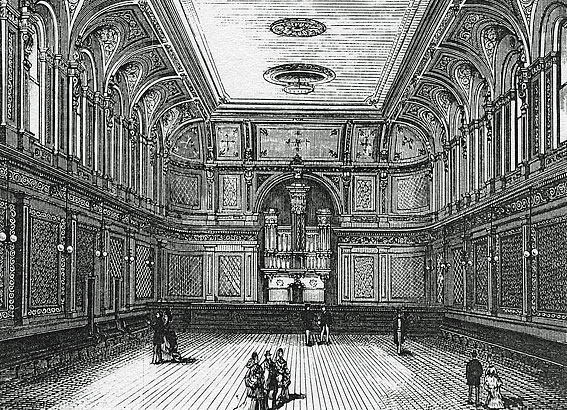
In the Melbourne newspaper The Argus 1 October 1853, p.7, an advertisement appeared as follows:
FOR Sale by Tender, a powerful and fine-toned CATHEDRAL ORGAN. – Tenders are invited for the Purchase of a most splendid Organ, built to order, and expected to arrive in Melbourne about the middle of October.
The above instrument has two entire rows of Manuals compass, from FFF to F in alt, with twenty stops, one octave and a half of pedals, and two composition pedals. The height of the case is 19 feet, width 8 feet 11 inches and depth 8 feet.
Such an opportunity as the present should not be lost to secure so perfect and chaste an instrument, combining great power and variety of expression, whilst by means of the swell (which is on an entirely new principle, and peculiar to the builders Messrs Smith of Bristol only) it commands at all times a soft and melodious accompaniment. A new stop has also been introduced, called the Keraulophon which has a beautiful effect, and is an addition of great merit. The want of organs of this class in places of worship in the colonies is greatly felt, but hitherto the expense has prohibited their introduction; and had the church which the above instrument was intended for been in a state to receive it, the public would not have the opportunity the present offers them. The following extract from an English paper will give an idea of the intrinsic value in the musical world at home, from the Bristol Mirror of June 28th, 1853 –
“We are glad to learn that Messrs Smith of Stoke Croft have received and executed an order for an organ of large capacity for Melbourne. The instrument consists of two entire rows of keys, compass five octaves each, and the swell, which is of a very peculiar and effective construction, extends over four octaves, and contains seven stops; it produces extraordinary effects – ‘diminuendo et crescendo.’ The pedal range is nearly two octaves, and the great organ contains eleven stops; it has all the recent improvements, and musicians of very high standing who have tried, have pronounced it to be a very first class instrument and reflects great credit on the builders, Messrs Smith.”
Liberal terms will be accepted. The instrument will be guaranteed perfect, and delivered free of expense to the purchaser. Further details may be obtained on application to Mr H. SMITH (son of the builder) Organ Builder, at Messrs H. Jones and Cole (late Maples) Watchmakers and Jewellers &c, 126 Elizabeth-street, opposite the Post Office, Melbourne, to whom Tenders must be addressed.
This organ appears to be the instrument purchased by the Philharmonic Society and erected at the Mechanics Hall, Melbourne by Henry Smith for £80. It was then recorded as being a two manual organ of 20 stops and 765 pipes. It was opened on 14 March 1854. It was one of five organs by Smith & Son brought to Melbourne at the time, the others being at St Paul’s Church and St Peter’s Church, Melbourne, and for two private clients – probably small chamber organs.
The interior of the Melbourne Athenaeum, previously the Mechanics Institute, was illustrated in the Illustrated Australian News for Home Readers, 5 December 1872. An organ is shown in at the end of the building and it seems as if this was the Smith organ, although it had been removed to East Melbourne four years earlier. Maybe it was just an artist’s fantasy?
The Argus of 19 October 1868, p.5 recorded the sale of the organ and pianoforte belonging to the Philharmonic Society. The organ was sold to Holy Trinity Church in East Melbourne where it was opened by David Lee on 17 June 1869 who, it was noted in The Argus of 18 June 1869, p.5, brought out the “improved qualities of the instrument.”
The specification of the Smith & Sons organ was recorded by George Fincham on 31 March 1900 (letter books p.449):
| GREAT Open Diapason Stopt Diapason Bass Stopt Diapason Treble Keraulophon Celestina Principal Flute Fifteenth SWELL Open Diapason Stopt Diapason Principal Twelfth Fifteenth Trumpet Oboe PEDAL Open Diapason |
8 8 8 8 8 4 4 2 8 8 4 2-2/3 2 8 8 16 |
54 pipes 12 pipes 42 pipes 42 pipes 42 pipes 54 pipes 42 pipes 54 pipes 42 pipes 54 pipes 54 pipes 42 pipes 42 pipes 42 pipes 42 pipes 24 pipes |
It appears at this stage that the key compasses had been reduced to CC rather than the FF below. Three stops appear to be missing from the Great Organ, which was originally described as having 11 stops although the 11 stops may have included the three couplers usually provided. Alternatively, it would seem that a Twelfth, Mixture or Sesquialtera, and Trumpet may have been expected in an organ of this size and these were indeed present on the Smith organ acquired by St Paul’s Church, Melbourne shortly afterwards.
The organ was rebuilt in 1900 by Geo. Fincham & Son who extended the key compasses upwards and added four stops at a cost of £320.
The organ and the church were destroyed by fire on 1 January 1905 and the specification, recorded on 6 January 1905 (letter books p.380) reads:
| GREAT Open Diapason Stop Diapason Dulciana Principal Twelfth Fifteenth Trumpet SWELL Open Diapason Stop Diapason Gamba Voix Celeste Principal Fifteenth Cornopean Oboe PEDAL Open Diapason Bourdon |
8 8 8 4 3 2 8 8 8 8 8 4 2 8 8 16 16 |
56 pipes 56 pipes 44 pipes 56 pipes 56 pipes 56 pipes 56 pipes * 56 pipes 56 pipes 56 pipes * 44 pipes * 56 pipes 56 pipes 56 pipes 56 pipes 30 pipes 30 pipes * |
* possibly the added stops
SECOND ORGAN
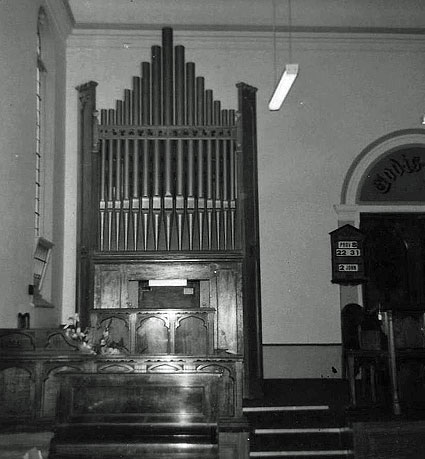
On 5 January 1906, Geo Fincham & Son recorded the details of a hire organ for Holy Trinity Church, East Melbourne in course of construction in our factory (specification book vol 23, 1905-1912, p.32):
| GREAT Open Diapason Stopped Diapason Dulciana Principal Flute Fifteenth SWELL Open Diapason Gedact Gamba Voix Celeste Octave Piccolo Oboe PEDAL Bourdon |
8 8 8 4 4 2 8 8 8 8 4 2 8 16 |
gvd.bass TC |
Compass: 56/30
3 couplers
3 composition pedals to Great
3 composition pedals to Swell
Width 8ft
Depth 8ft 6 in including stool
This instrument incorporated second-hand parts and was purchased from Geo Fincham & Son in 1913 by William Anderson. It was moved to the Church of Christ, Lygon Street, Carlton where it survives unaltered. On 15 December 1913, Geo. Fincham & Son invoiced Wm Anderson “enclosed please find a/c for erection of organ at Carlton.”
PRESENT ORGAN
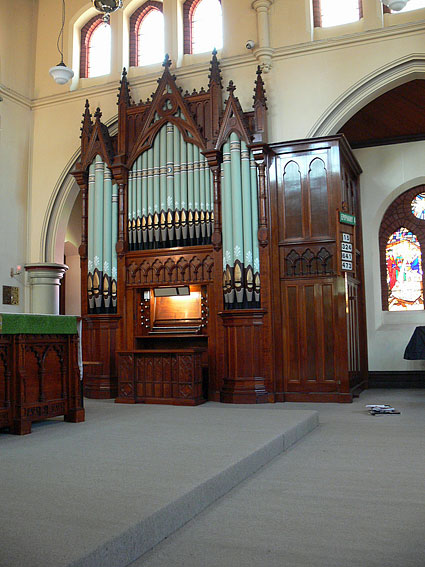
In The Age for 19 and 30 October 1912, advertisements appeared for the sale of a pipe organ in a house in Fordholm Road, Hawthorn. The property was 'Yarradale' and had belonged to Henry M. Boom, who as far back as June 1872 imported from J.W. Walker in London assorted pipework of 'fine spotted metal' at a cost of 50 pounds. This included part of an Open Diapason 8 (37 pipes), Principal, Dulciana and two Fifteenth top octaves. Details are recorded in the firm's order books for the time, page 289. The choice of Walker for the pipework is interesting as almost over the back fence from where Boom was living at the time was 'Rose Hill', the property of William Philpott, who had ordered a three-manual organ from this firm in 1865, now at St Stephen's, Richmond. Philpott may well have provided Boom with an introduction to Walker.
The Sands & McDougall municipal directories of Melbourne record that in 1870, Henry M. Boom resided in the suburb of Malvern. In 1875 the directories recorded that he was a clerk in the Government Printing Office while in 1881 he had risen to the position of accountant there. The house in Malvern was in Toorak Road. Its name was 'Brinkly, and was located on the south side of the road, east of Glenferrie Road. In 1905 Boom was living at a house in Toorak Road, Malvern known as 'Villette'. In 1908 he must have moved to Fordholm Road in Hawthorn and is recorded as living there at 'Yarradale', on the eastern side of the road, up to 1912.
On 8 February 1912, L.V.H. Fincham wrote to Alex Ground:
“I have promised Mrs Boom first consideration on your return, only trifles to fix up. She had Mr Boom in the cab, he looks about done…”
On 8 August 1912, L.V.H. Fincham recorded the following valuation:
“Mrs H.M. Boom, Fordholm Rd, Hawthorn. Pipe organ at ‘Yarradale’ – market value + hydraulic motor and generator £300. Pipework rather light in scale for a church of moderate size.”
Henry Boom appears to have died before August 1912 as ‘Yarradale’ was auctioned later that year: the property was then listed as being in the estate of the late Mr H.M. Boom. In 1913, according to the municipal directories, the property is listed in the name of Mrs G.E. Boom while in 1914 the Boom family had departed.
The Argus, 23 November 1912, p.2 records:
WEDNESDAY DECEMBER 11.
At Three O Clock
At the AUCTION ROOMS, 350 COLLINS STREET.
By order of
THE TRUSTEES, EXECUTORS AND AGENCY CO. LTD.
In the estate of the late Mr. H.M. Boom.
SUPERIOR BRICK VILLA RESIDENCE,
Known as
“YARRADALE,”
FORDHOLM-ROAD
(Off Riversdale-road and Close to Glenferrie-road),
HAWTHORN.
The Land has a Frontage of 135ft. 8in. to FORDHOLM-ROAD by a Depth of 194ft. 10in. Along YARRA-GROVE, Upon Which is Erected a BRICK-VILLA, Tile Roof, with Wide Verandah, Containing Entrance Hall, Magnificent Drawing-room or Music-room, with Handsome Wooden Gothic Ceiling, with Ante-room Off, Diningroom, Best Bedroom, 2 Other Bedrooms, Maid’s Room, Bathroom, Pantries, Kitchen, Scullery, and Laundry Combined.
The Outbuildings Comprise Timber Workshop, with Iron Roof, 21ft. x 13ft., Also Wood and Coal Shed.
The Garden is Tastefully Laid Out into Lawns, Flower Garden; there is Also a Good Grass Run for Fowls.
The Property is Situated Within Three Minutes’ Walk of the Riversdale-road Tram, and About Five Minutes from the Kew, Glenferrie, St. Kilda Electric Tram, Which Will be Running Within Four Months.
Early Possession.
Title, Certificate, Apply to Messrs. F.G. SMITH and M’EACHARN, Solicitors, 235 Collins-street.
TERMS – ¼ CASH, ¼ in 3 YEARS, and BALANCE in 5 YEARS at 5 PER CENT.
Also,
Organ (Pipe), 2 Manuals, Pedals, Great 8, Swell 4, Pedal, Couplers 5, Tremulant to Swell, 3 Composition Pedals, Magnificent Instrument; Suit Church, Large Hall, or Gentleman’s Residence.
Can be Seen at Yarradale.
To be Offered Immediately After the Property, On Account of Mrs. H.M. Boom.
Orders to View Must be Obtained from the Auctioneers.
TUCKETT and STYLES, 359 Collins-street (Baseement);
GEMMELL, TUCKETT, and CO. PTY.LTD, 361 Collins-street
(Auctioneers in Conjunction)
The Age ran similar advertisements for the organ:
ORGAN (pipe), 2 manuals, pedals, great 8 - swell 4- pedal 1 , coupler, 5. tremulant to swell, 3 composition pedals, Yarradale, Fordholm-rd, off Riversdale-rd., Glenferrie
ORGAN (pipe), splendid tone, 2 manuals, pedals, hydraulic engine, attached to air generator, magnificent case, Gothic design, fiddleback, blackwood, perfect order, little used, suitable church, gentleman's residence. Mrs. BOOM, Fordholm-road, Glenferrie.
The minute books of Holy Trinity Anglican Church, Clarendon Street, East Melbourne record that a pipe organ was acquired at that time through William Anderson. It was later maintained by Frederick Taylor. The date of acquisition is likely to have been around May 1913 as the previous organ at Holy Trinity Church was sold in that month.
The number of stops on each department of Mr Boom's organ exactly coincides with those at Holy Trinity. The casework was described in the advertisements as 'fiddleback blackwood of Gothic design'. It is likely that the casework may have been made by the Kew organbuilder Alfred Fuller, or at least copied from one of his organs. The arcading above the console is identical to the Fuller organ at St John's, Essendon. The upper casework is separately made from the lower casework and even the holes drilled in the console doors are reminiscent of where Alfred Fuller’s trademark crystal knobs may have been placed. The painted numbering on the rear of the façade pipes looks rather like what Alfred Fuller employed, to be seen at Fawkner and North Fitzroy.
It looks as if Boom probably built most of the organ, but maybe with some assistance from a professional organbuilder, such as Alfred Fuller close by in Kew, or Fred Taylor, who was even closer in Burwood Road, Hawthorn. The house was equipped with a large workshop, so clearly he must have been something of an expert in this craft. The choice of a Portunal stop on the Great is of some interest as these were a great rarity locally. Taylor used such a register on several of his organs (including that in the Methodist Church, Armadale) while the Randebrock organ at St Kilian's, Bendigo incorporated what was probably the prototype. James Ingall Wedgwood, in his Dictionary of Organ Stops (London: Vincent, c.1905), p.118, described the Portunal as 'composed of open wooden pipes widening as they ascend. The tone is velvety and often accompanied by a modicum of string tone…' However, here Boom’s Portunal is only a non-tapering wooden Hohl Flute with inverted mouths.
In order to save space, there was originally no passage board provided between the Great and Swell windchests and tuning access was through the middle of the facade. The pipes are all very closely planted and the manual roller boards are constructed using brass tubes, which save space. The pedal roller board, however, has timber rollers and arms.
Boom appears to have made most of the wooden pipes. The stopped pipes show a variety of stopper shapes, extending to widespread use of pierced stoppers – and indeed some ingenuity in the use of turned wooden pipe feet for the bass of the Great Stopd Diapason. The fronts of several of the swell ranks are made in costly mahogany.
After 1940 the front casework was extended to the right and new side panelling made to face down the south aisle. It would appear that the organ was hand blown from the right hand side judging from the graffiti which remains on the inside wall in this area.
Hill, Norman & Beard (Australia) Pty Ltd renovated the organ in 1972. At this time, the pedal Bourdon was moved to the side of the organ and placed on electric action. The swell slider chest was moved backwards to allow a passage board to be inserted between the great and swell: previously the façade pipes had to be removed to gain access for tuning, etc. The swell box was removed and the Oboe replaced by a two-rank Mixture 19.22. As the swell consisted only of 8, 4 and 2ft wooden flutes this was not disastrous although the removal of the reed was unfortunate. The facade pipes which had been silvered have more recently been tastefully restencilled.
The specification of the organ up to 1972 was as follows:
| GREAT Open Diapason Stopd. Diapason Portunal Dulciana Principal Stopd. Flute Twelfth Fifteenth Octave coupler Swell to Great SWELL Stopd. Diapason Flute Piccolo Clarionet [Oboe] PEDAL Bourdon Bass Flute Great to Pedal Swell to Pedal Octave Pedal |
8ft 8ft tone 8ft 8ft 4ft 4ft tone 2-2/3 2 8ft tone 4 2 8 16ft tone 8 |
wood mid.C up: bass from Stopd. Diapason wood wood open wood TC – removed 1971 (swell box removed 1971) wood open wood stopped wood, metal top octave replaced by Mixture 19.22 II 1971 A A – removed 1971 |
Compass: 56/30
3 composition pedals
Trigger swell pedal (removed 1971)
The pedal Bourdon now operates on electro-pneumatic action and is extended to a Bass Flute 8, replacing the pedal octave coupler.
The instrument has enormous charm tonally, with an elegance and pleasing quality rarely to be found.

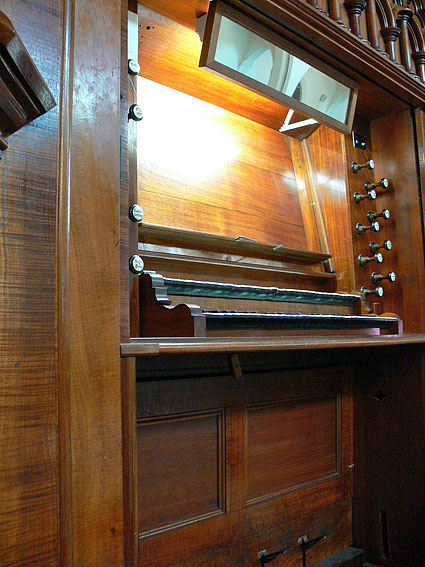
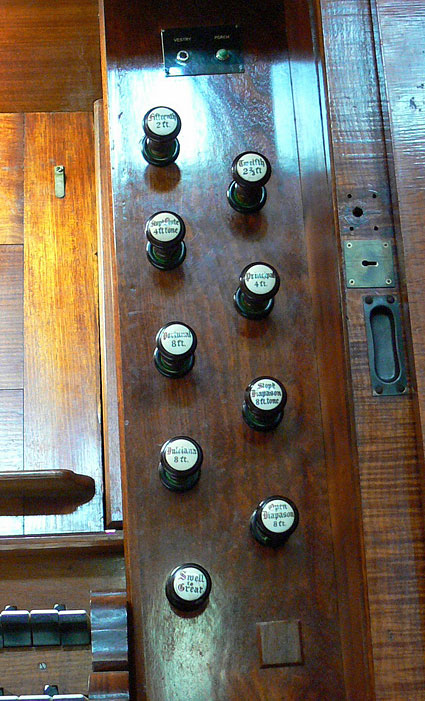
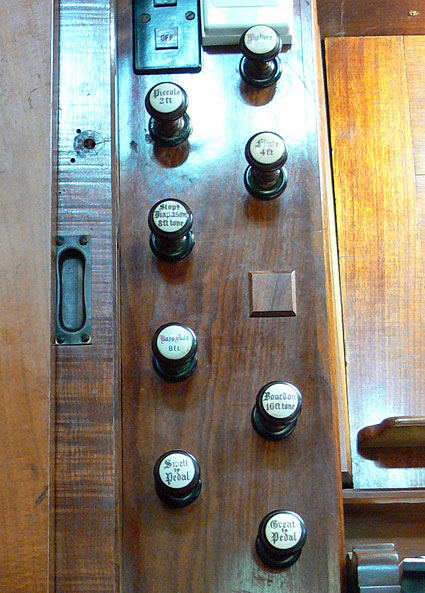
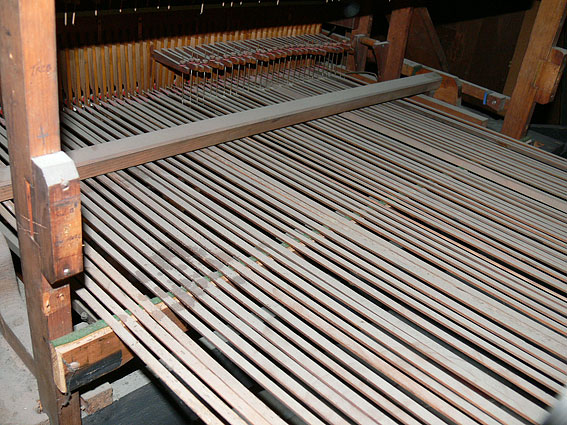
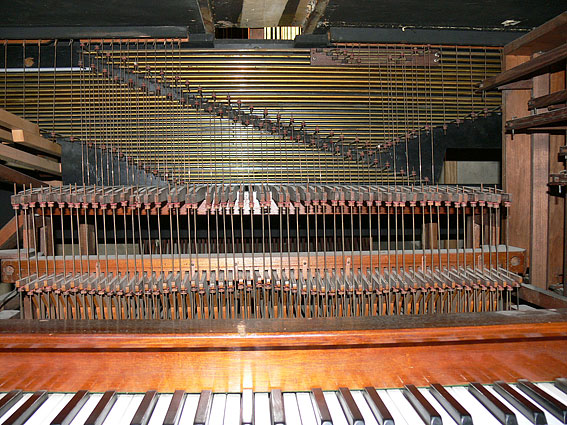
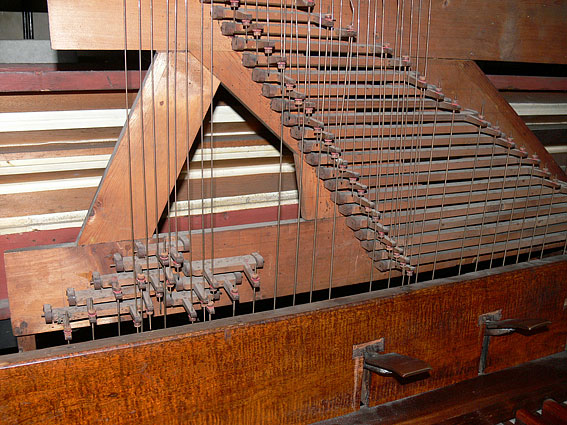
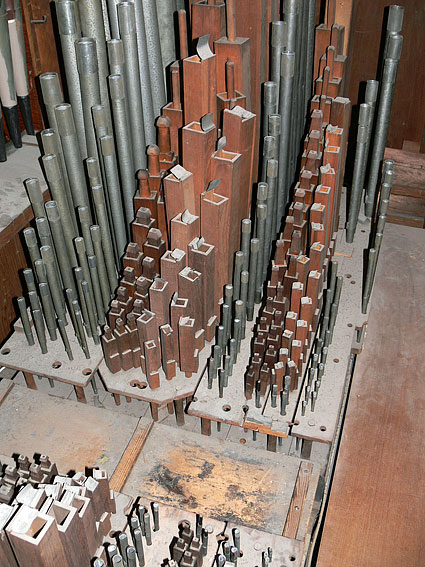
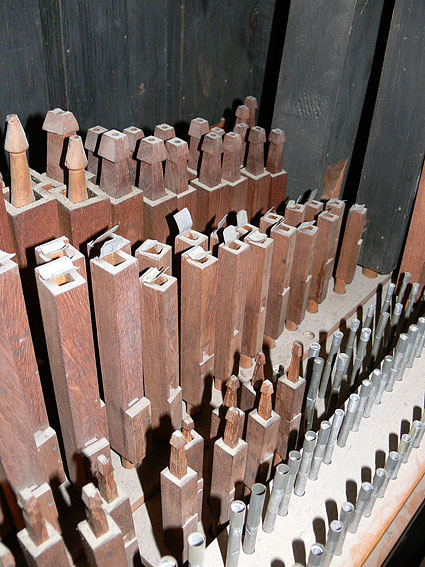
Photos: JRM (Feb 2010)
John Maidment
4 February 2010